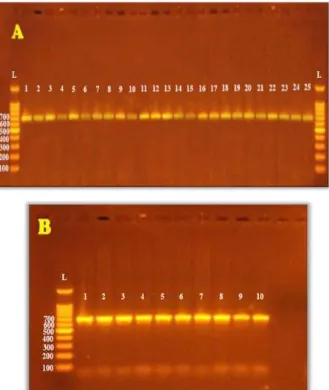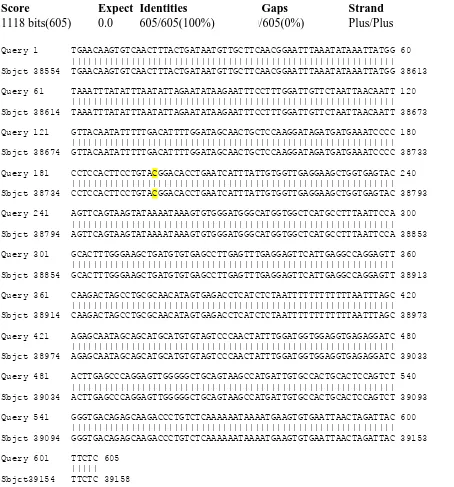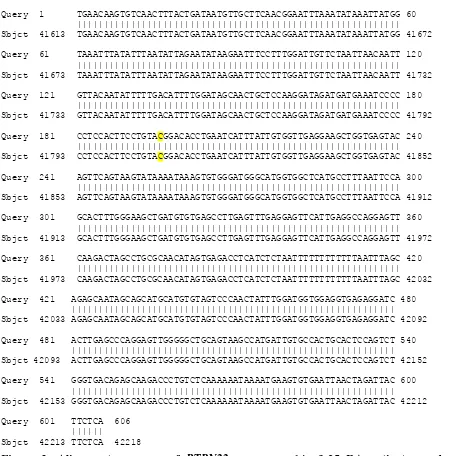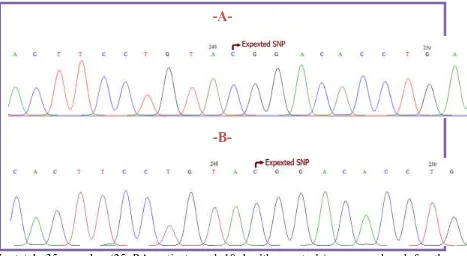GENETIC POLYMORPHISM IN PROTEIN TYROSINE
PHOSPHATASE NON-RECEPTOR 22 (
PTPN22
)
GENE IN IRAQI
PATIENTS WITH RHEUMATOID ARTHRITIS
Ahmed Yaseen AL-Tarboolii*1, Hameed Majeed Jassim2, Mohammed Hadi Alosami3,
4
Saleh Ahmed Wohaieb
1
College of Science/Al-Nahrain University
2
College of Applied Biotechnology/Al-Nahrain University
3
College of Medicine /Baghdad University
4
College of Applied Biotechnology/Al-Nahrain University
ABSTRACT
Rheumatoid arthritis (RA) is a common autoimmune disease
characterized by chronic inflammation and joint destruction. The aim
of the present study was to investigate the genetic polymorphism
(rs2746601) for the gene encoding protein tyrosine phosphatase
non-receptor 22 (PTPN22) gene in Iraqi RA patients. A total of 35 samples
(25 RA patients and 10 healthy controls) were recruited in this study.
Genetic polymorphism in Protein Tyrosine Phosphatase non-receptor
22 (PTPN22) was studied for rs2476601 SNP in exon 14 within
chromosome 1. This SNP (rs2476601) was regarded as a major risk
factor associated with susceptibility and severity of rheumatoid
arthritis. Genomic DNA was first extracted from blood samples for healthy controls and
treated RA patients. Results showed that the concentration of extracted DNA ranged between
100-200 ng/μl with purity of 1.8-2.0. Then exon 14 was amplified by using specific primers
designed in this study. Results of amplification showed a single band of 684bp was obtained
after electrophoresis on agarose gel (1.8%) which represents the complete nucleotide
sequence of exon 14. To examine genetic polymorphism (rs2476601) in this exon, the
nucleotide sequence for this fragment was determined. Results showed that the rs2476601
SNP was non-polymorphic in both RA patients and healthy control subjects with total
absence of the variant ‘T’ allele. Furthermore, the frequency of the ‘T’ allele was 0.0, with
T/T, C/T and C/C genotype frequencies of 0.0, 0.0, and 1.0, respectively. In conclusion, this
Volume 5, Issue 6, 340-350. Research Article ISSN 2277– 7105
*Corresponding Author Ahmed Yaseen AL-Tarboolii
College of Science/Al-Nahrain University
Article Received on 12 April 2016,
Revised on 03 May 2016, Accepted on 24 May 2016
study shows that the rs2476601 SNP of the PTPN22 gene is non-polymorphic in Iraqi
population and therefore not associated with RA. However, since variations in the rest of the
gene were not investigated, these results do not exclude other PTPN22 polymorphisms from
playing a role in RA susceptibility in Iraq.
INTRODUCTION
Rheumatoid arthritis is a chronic inflammatory autoimmune disease characterized by
synovial inflammation and structural damage of joints[1]. The diagnosis of rheumatoid
arthritis is based on clinical manifestations of joints and serological markers[2]. Rheumatoid
arthritis patients are characterized by presenting some circulating auto antibodies in their
serum. In clinical practice the most common diagnostic test is rheumatoid factor (RF) and
anti-cyclic citrullinated peptide (anti-CCP) and is generally accepted by the majority of
rheumatologists and recommended by the European League of Arthritis and Rheumatism
(EULAR)[3].
The etiology of RA, like other autoimmune disorders are not fully understood[4]. However,
RA is complex disorder that interactions of genetic and environmental factor contribute to
susceptibility[5]. Genetic factors contribute 50% to 60% of the risk of developing RA. The
major genetic risk factors that have been reproducibly shown strong association with
susceptibility are Human leukocyte antigen of DRB1 alleles Human leukocyte antigen of
DRB1 alleles (HLA-DRB1), and Protein tyrosine phosphatases non- receptor 22 (PTPN22)
genes[6][7]. Among non-HLA genes, the main RA susceptibility factor is the
tyrosine-phosphatase gene PTPN22 on chromosome.[8] A missense C→T substitution at nucleotide
position 1858 (rs2476601) of this gene leads to substitution of tryptophan (W) for arginine
(R) at residue 620 of the protein product.[9] The resulting gain of function, with enhanced
regulation of T-cell receptor (TCR) signaling during thymic selection, permits autoantigen
specific T cells to escape clonal deletion, thereby predisposing to autoimmunity.[10] This
PTPN22 polymorphism is not seen in Asian populations, may be only with Asiatic Indians
with RA positive.[11]
MATERIALS AND METHODS
Subjects
Blood samples (3-5 ml) were collected in EDTA anticoagulant tubes from 25 male and
Teaching Hospital through the period from November 2014 to June 2015. Another blood
samples were collected from 10 apparently healthy controls.
Extraction of Genomic DNA
Total genomic DNA was extracted from blood samples by using ReliaPrep™ Blood gDNA
Miniprep System supplied by Promega Company (USA).
Amplification of Protein Tyrosine Phosphatase Non-receptor 22 Exon 14
Amplification of PTPN22 was achieved by using specific primers indicated in (Table 1).
These primers were designed in this study and were supplied by Alpha DNA Company in a
lyophilized form of different picomols concentrations. Lyophilized primers were dissolved in
a free DNase/RNase water to give a final concentration of 100 pmol/μl as a stock solution. A working solution of 10 pmol/μl of these primers was prepared by adding 10μl of primer stock
solution to 90μl of deionized distilled water to get a final concentration of 10 pmol/μl.
Table 1: Oligonucleotide primers used for the amplification of PTPN22 Exon 14
Primer Sequence (5'→ 3') Product Size (bp)
Forward AAGAATAAGCAAAAACCTCCTGGG
684 Reverse AACATTGAAAGGACCTGAGAAGT
PCR amplification program for Exon 14 of PTPN22 was achieved by initial denaturation for
one cycle at 95 °C for 4min., followed by 30 cycles of denaturation at 95 °C for 30sec,
annealing at 60 °C for 30sec, extension at 72 °C for 30sec, and the final extension for one
cycle at 72 °C for 7min.
Sequencing of amplification products
Amplification products for exon 14 of the gene PTPN22 was sent for sequencing to
Macrogen Company (USA). Then, the sequencing for these products was compared with the
information in gene bank of the National Center for Biotechnology Information (NCBI) for
standard PTPN22 gene, using (Bioedit) software.
RESULTS AND DISCUSSIONS
Genomic DNA was first extracted from blood samples of pateints and healthy controls by
using ReliaPrep™ Blood gDNA Miniprep System (Promega / USA). The concentration of
the purity was ranged between 1.8-2.0. This purity and concentration of DNA solutions were
suitable and recommended for further genetic analysis by using PCR technique[12].
Polymerase chain reaction was used to amplify exon 14 of PTPN22 in the extracted genomic
DNA under optimum amplification conditions by using specific primers shown previously.
Results illustrated in (Figure 1) showed a single band of the amplified product with a
molecular size of 684 base pair after electrophoresis on agarose gel (1.8%). These DNA
[image:4.595.118.447.253.643.2]fragments represent the region of exon 14 for PTPN22 gene located on chromosome 1p13[13].
Figure 1: Gel electrophoresis for PCR products of PTPN22 gene exon 14 on agarose gel
(1.8%) after electrophoresis for 1 hour at 5 v/cm2 in the presence of 1 kb DNA Ladder
marker. (A) PCR products for DNA extracted from blood samples of patients with
Rheumatoid arthritis. (B) PCR products for DNA extracted form blood samples of
Sequencing of Amplified Exon 14 of PTPN22 Gene
In this study, twenty five Iraqi patients with rheumatoid arthritis were recruited to investigate
the relationship between rs2476601 SNP in exon 14 of PTPN22 gene and the severity of the
disease compared with ten Iraqi healthy controls.
Protein Tyrosine Phosphatase (PTPN22) gene was the first non-HLA gene that associated
with rheumatoid arthritis[14]. PTPN22encodes the lymphoid tyrosine phosphatase (LYP) that
modulates the activation of both T and B cells [15]. Single nucleotide polymorphisms (SNPs)
in PTPN22 gene (rs2476601) are highly associated with the disease in several ethnic
populations[16], and regarded as the most important risk factor associated with the
susceptibility of RA[17]. In the European population, the second strongest genetic risk outside
of the HLA region is a functional single nucleotide polymorphism (SNP) in the PTPN22 gene
which is a C→T substitution at nucleotide position 1858 (rs2476601), which results in a
substitution of tryptophan (W) for arginine (R) at codon 620[10]. However, the rs2476601
SNP was not found to be associated with RA in the Asian population[18] [19].
Nucleotide sequence of exon 14 was analyzed by blastn in the National Center Biotechnology
Information (NCBI) online at (http:// www.ncbi.nlm.nih.gov) and BioEdit program to detect
rs2476601 polymorphism in exon 14 of PTPN22 gene. Results illustrated in (Figure 2)
showed the nucleotide sequence alignment and the position of the cytosine (C) nucleotide of
healthy control group matched with cytosine (C) nucleotide in reference sequence mentioned
in NCBI, that showed 100% identity, under Sequence ID: gb|EF064714.1| from 38554-39158
number of nucleotide from Homo sapiens protein tyrosine phosphatase, non-receptor type 22
(lymphoid) (PTPN22) gene, from Gene Bank , with score (1118) and expect 0.0.
On the other hand, results of sequencing of PTPN22 exon 14 in Iraqi patient with rheumatoid
arthritis illustrated in (Figure 3) and (Table 2) that showed that nucleotide alignment of RA
patients group compared with reference sequence mentioned in NCBI, with 100% identity,
under sequence ID: ref|NG_011432.1|from 41613-42218 number of nucleotide from Homo
sapiens Protein Tyrosine Phosphatase, non-receptor type 22 (PTPN22), Ref Seq Gene on
chromosome 1.
Homo sapiens protein tyrosine phosphatase, non-receptor type 22 (lymphoid) (PTPN22)
Score Expect Identities Gaps Strand
1118 bits(605) 0.0 605/605(100%) 0/605(0%) Plus/Plus
Query 1 TGAACAAGTGTCAACTTTACTGATAATGTTGCTTCAACGGAATTTAAATATAAATTATGG 60 |||||||||||||||||||||||||||||||||||||||||||||||||||||||||||| Sbjct 38554 TGAACAAGTGTCAACTTTACTGATAATGTTGCTTCAACGGAATTTAAATATAAATTATGG 38613
Query 61 TAAATTTATATTTAATATTAGAATATAAGAATTTCCTTTGGATTGTTCTAATTAACAATT 120 |||||||||||||||||||||||||||||||||||||||||||||||||||||||||||| Sbjct 38614 TAAATTTATATTTAATATTAGAATATAAGAATTTCCTTTGGATTGTTCTAATTAACAATT 38673
Query 121 GTTACAATATTTTTGACATTTTGGATAGCAACTGCTCCAAGGATAGATGATGAAATCCCC 180 |||||||||||||||||||||||||||||||||||||||||||||||||||||||||||| Sbjct 38674 GTTACAATATTTTTGACATTTTGGATAGCAACTGCTCCAAGGATAGATGATGAAATCCCC 38733
Query 181 CCTCCACTTCCTGTACGGACACCTGAATCATTTATTGTGGTTGAGGAAGCTGGTGAGTAC 240 |||||||||||||||||||||||||||||||||||||||||||||||||||||||||||| Sbjct 38734 CCTCCACTTCCTGTACGGACACCTGAATCATTTATTGTGGTTGAGGAAGCTGGTGAGTAC 38793
Query 241 AGTTCAGTAAGTATAAAATAAAGTGTGGGATGGGCATGGTGGCTCATGCCTTTAATTCCA 300 |||||||||||||||||||||||||||||||||||||||||||||||||||||||||||| Sbjct 38794 AGTTCAGTAAGTATAAAATAAAGTGTGGGATGGGCATGGTGGCTCATGCCTTTAATTCCA 38853
Query 301 GCACTTTGGGAAGCTGATGTGTGAGCCTTGAGTTTGAGGAGTTCATTGAGGCCAGGAGTT 360 |||||||||||||||||||||||||||||||||||||||||||||||||||||||||||| Sbjct 38854 GCACTTTGGGAAGCTGATGTGTGAGCCTTGAGTTTGAGGAGTTCATTGAGGCCAGGAGTT 38913
Query 361 CAAGACTAGCCTGCGCAACATAGTGAGACCTCATCTCTAATTTTTTTTTTTTAATTTAGC 420 |||||||||||||||||||||||||||||||||||||||||||||||||||||||||||| Sbjct 38914 CAAGACTAGCCTGCGCAACATAGTGAGACCTCATCTCTAATTTTTTTTTTTTAATTTAGC 38973
Query 421 AGAGCAATAGCAGCATGCATGTGTAGTCCCAACTATTTGGATGGTGGAGGTGAGAGGATC 480 |||||||||||||||||||||||||||||||||||||||||||||||||||||||||||| Sbjct 38974 AGAGCAATAGCAGCATGCATGTGTAGTCCCAACTATTTGGATGGTGGAGGTGAGAGGATC 39033
Query 481 ACTTGAGCCCAGGAGTTGGGGGCTGCAGTAAGCCATGATTGTGCCACTGCACTCCAGTCT 540 |||||||||||||||||||||||||||||||||||||||||||||||||||||||||||| Sbjct 39034 ACTTGAGCCCAGGAGTTGGGGGCTGCAGTAAGCCATGATTGTGCCACTGCACTCCAGTCT 39093
Query 541 GGGTGACAGAGCAAGACCCTGTCTCAAAAAATAAAATGAAGTGTGAATTAACTAGATTAC 600 |||||||||||||||||||||||||||||||||||||||||||||||||||||||||||| Sbjct 39094 GGGTGACAGAGCAAGACCCTGTCTCAAAAAATAAAATGAAGTGTGAATTAACTAGATTAC 39153
Query 601 TTCTC 605 ||||| Sbjct39154 TTCTC 39158
Figure 2: Alignment sequence of PTPN22 gene exon 14 of 10 healthy control samples
compared with standard PTPN22 gene exon 14, obtained from Gene Bank. Query
represents of samples; Sbject represent of database of National Center Biotechnology
Information (NCBI). Yellow letters indicate the position of expected SNP.
Homo sapiens protein tyrosine phosphatase, non-receptor type 22 (lymphoid) (PTPN22)
gene, Sequence ID: ref|NG_011432.1|
Score Expect Identities Gaps Strand
[image:6.595.71.525.72.559.2]Query 1 TGAACAAGTGTCAACTTTACTGATAATGTTGCTTCAACGGAATTTAAATATAAATTATGG 60 |||||||||||||||||||||||||||||||||||||||||||||||||||||||||||| Sbjct 41613 TGAACAAGTGTCAACTTTACTGATAATGTTGCTTCAACGGAATTTAAATATAAATTATGG 41672
Query 61 TAAATTTATATTTAATATTAGAATATAAGAATTTCCTTTGGATTGTTCTAATTAACAATT 120 |||||||||||||||||||||||||||||||||||||||||||||||||||||||||||| Sbjct 41673 TAAATTTATATTTAATATTAGAATATAAGAATTTCCTTTGGATTGTTCTAATTAACAATT 41732
Query 121 GTTACAATATTTTTGACATTTTGGATAGCAACTGCTCCAAGGATAGATGATGAAATCCCC 180 |||||||||||||||||||||||||||||||||||||||||||||||||||||||||||| Sbjct 41733 GTTACAATATTTTTGACATTTTGGATAGCAACTGCTCCAAGGATAGATGATGAAATCCCC 41792
Query 181 CCTCCACTTCCTGTACGGACACCTGAATCATTTATTGTGGTTGAGGAAGCTGGTGAGTAC 240 |||||||||||||||||||||||||||||||||||||||||||||||||||||||||||| Sbjct 41793 CCTCCACTTCCTGTACGGACACCTGAATCATTTATTGTGGTTGAGGAAGCTGGTGAGTAC 41852
Query 241 AGTTCAGTAAGTATAAAATAAAGTGTGGGATGGGCATGGTGGCTCATGCCTTTAATTCCA 300 |||||||||||||||||||||||||||||||||||||||||||||||||||||||||||| Sbjct 41853 AGTTCAGTAAGTATAAAATAAAGTGTGGGATGGGCATGGTGGCTCATGCCTTTAATTCCA 41912
Query 301 GCACTTTGGGAAGCTGATGTGTGAGCCTTGAGTTTGAGGAGTTCATTGAGGCCAGGAGTT 360 |||||||||||||||||||||||||||||||||||||||||||||||||||||||||||| Sbjct 41913 GCACTTTGGGAAGCTGATGTGTGAGCCTTGAGTTTGAGGAGTTCATTGAGGCCAGGAGTT 41972
Query 361 CAAGACTAGCCTGCGCAACATAGTGAGACCTCATCTCTAATTTTTTTTTTTTAATTTAGC 420 |||||||||||||||||||||||||||||||||||||||||||||||||||||||||||| Sbjct 41973 CAAGACTAGCCTGCGCAACATAGTGAGACCTCATCTCTAATTTTTTTTTTTTAATTTAGC 42032
Query 421 AGAGCAATAGCAGCATGCATGTGTAGTCCCAACTATTTGGATGGTGGAGGTGAGAGGATC 480 |||||||||||||||||||||||||||||||||||||||||||||||||||||||||||| Sbjct 42033 AGAGCAATAGCAGCATGCATGTGTAGTCCCAACTATTTGGATGGTGGAGGTGAGAGGATC 42092
Query 481 ACTTGAGCCCAGGAGTTGGGGGCTGCAGTAAGCCATGATTGTGCCACTGCACTCCAGTCT 540 |||||||||||||||||||||||||||||||||||||||||||||||||||||||||||| Sbjct 42093 ACTTGAGCCCAGGAGTTGGGGGCTGCAGTAAGCCATGATTGTGCCACTGCACTCCAGTCT 42152
Query 541 GGGTGACAGAGCAAGACCCTGTCTCAAAAAATAAAATGAAGTGTGAATTAACTAGATTAC 600 |||||||||||||||||||||||||||||||||||||||||||||||||||||||||||| Sbjct 42153 GGGTGACAGAGCAAGACCCTGTCTCAAAAAATAAAATGAAGTGTGAATTAACTAGATTAC 42212
Query 601 TTCTCA 606 ||||||
Sbjct 42213 TTCTCA 42218
Figure 3: Alignment sequence of PTPN22 gene exon 14 of 25 RA patient samples
compared with standard PTPN22 gene exon 14, obtained from Gene Bank. Query
represents of samples; Sbject represent of database of National Center Biotechnology
Information (NCBI). Yellow letters indicate the position of expected SNP.
Table 2: Sequencing ID in Gene Bank, Score, Expect, and Compatibility of DNA
sequences for PTPN22 gene.
Number of
samples Accession Compatibility Expect Score
Number of nucleotides 10
Controls gb|EF064714.1| 100 % 0.0 1118 38554 - 39158 25
[image:7.595.71.527.63.519.2]In total, 35 samples (25 RA patients and 10 healthy controls) were analyzed for the
rs2476601 of PTPN22 gene. Results of analyzed sequence shower that all samples were
genotyped as homozygous CC (Figure 4) and (Table 3).
Figure 4: Sequencing result for rs2476601. Chromatogram shows homozygote CC
genotype for rs2476601 of PTPN22 gene. A: Healthy Control group, B: RA Patient
[image:8.595.74.541.72.328.2]group.
Table 3: Genotypes and allele frequency in patients and healthy controls.
Samples N Genotypes Alleles (Frequency)
C/C C/T T/T C T
Controls 10 10 0 0 1.00 0.00
RA Patients 25 25 0 0 1.00 0.00
N= Number of subject studied
In this study, the role of expected missense SNP (rs2476601) in a gene encoding PTPN22
was studied for its role in RA disease susceptibility and severity in Iraq population. Results
indicated in (Table 3) showed that the genetic variant in the position of the expected SNP
(rs2476601) was found to be non-polymorphic in all Iraqi population under study. These
results agree with those obtained by Mastana, et al, and Somayeh, et al, who found that the
rs2476601was non-polymorphic and play no role in susceptibility to RA and other
autoimmune diseases in Asian Iranian population, respectively [11] [16]. Song, et al, showed
that PTPN22 polymorphism (rs2476601) confers susceptibility to RA in populations with
different ethnicities, especially in European [20]. However, this does not mean that functional
-A-
polymorphisms of the PTPN22, other than rs247660 do not play a role in the incidence of RA
in Iraqi population. In the Japanese, PTPN22 allelic heterogeneity was studied, but none of
the 8 other SNPs present in the European populations, were found to be polymorphic[18].
Another explanation may be that the variants in the PTPN22 gene may reflect genuine
differences in the pathogenesis of RA between European and Iraqi patients. However, this
can only be said with certainty once all variants of the gene have been studied. Also, this
study shows further evidence of inter-ethnic genetic variability in RA at non-HLA loci in Iraq
population. Such inconsistent associations might reflect differences in sample size, although
this is unlikely in this study as the rs2476601 was non-polymorphic in both RA patients and
controls. These differences might also relate to clinical phenotypic differences between
populations[21].
In conclusion, the presence of imbalance of cytokine production oxidative stress in the
absence of the PTPN22 high risk allele of SNP (rs2476601), demonstrates the possible role of
these parameters in the pathogenesis of joint damage in Iraqi patients with RA. Furthermore,
the possibility of the role of other genetic variants, not yet identified, in Iraqi RA patients.
The findings show conclusively that the functional R620W variant, a major risk factor for RA
in European populations, is not present and therefore does not play a role in the pathogenesis
of RA in Iraq. The present results agree with those obtained by Nimmisha who demonstrated
that the functional R620W variant (rs2476601) in PTPN22geneis not present and therefore
does not play a role in the pathogenesis of RA in Black South African population [22].
REFERENCES
1. Westwood OM, Nelson PN, Hay FC. Rheumatoid factors: what's new?. Rheumatology
2006; 45(4): 379–385.
2. Arnett, F. C., Edworthy, S. M., Bloch, D. A., McShane, D. J., Fries, J. F., Cooper, N. S.,
et al. (1988). The American Rheumatism Association 1987 revised criteria for the
classification of rheumatoid arthritis. Arthritis and Rheumatism, 31(3): 315-324.
3. Combe B, Landewe R, Lukas C, et al. EULAR, recommendations for the management of
early arthritis: report of a task force of the European Standing Committee for
International Clinical Studies Including Therapeutics (ESCISIT). Ann Rheum Dis, 66,
2007; 34– 45.
4. Alamanosa Y and Drosos A. (2005). Epidemiology of adult rheumatoid arthritis.
5. Rindfleisch J and Muller D., 2005 - Diagnosis and Management of Rheumatoid Arthritis.
Am Fam Physician, 72: 1037-47, 1049-50.
6. Gregersen PK, Silver J, Winchester RJ. The shared epitope hypothesis. An approach to
understanding the molecular genetics of susceptibility to rheumatoid arthritis. Arthritis
Rheum 1987; 30: 1205-1213 [PMID: 2446635]
7. Diogo D, Okada Y, Plenge RM. Genome-wide association studies to advance our
understanding of critical cell types and pathways in rheumatoid arthritis: recent findings
and challenges. Curr Opin Rheumatol 2014; 26: 85-92 [PMID: 24276088 DOI:
10.1097/BOR.0000000000000012].
8. Song G, Bae S, Lee Y. Pathway analysis of genome-wide association studies on
rheumatoid arthritis. Clinical and experimental rheumatology. 2012; 31(4): 566-74.
9. Vang, T., Congia, M., Macis, M. D., Musumeci, L., Orrú, V., Zavattari, P., et al. (2005).
Autoimmune-associated lymphoid tyrosine phosphatase is a gain-of-function variant.
Nature Genetics, 37(12): 1317-1319. doi:10.1038/ng1673.
10.Begovich, A. B., Carlton, V. E., Honigberg, L. A., Schrodi, S. J., Chokkalingam, A. P.,
Alexander, H. C., et al. (2004). A missense single-nucleotide polymorphism in a gene
encoding a protein tyrosine phosphatase (PTPN22) is associated with rheumatoid
arthritis. American Journal of Human Genetics, 75(2): 330-337.
11.Mastana S, Gilmour A, Ghelani A, Smith H, Samanta A. Association of PTPN22 with
rheumatoid arthritis among South Asians in the UK. J Rheumatol 2007; 34: 1984-1986
[PMID: 17696275].
12.Boesenberg-Smith Kelly A., PSM, Mohammad M. Pessarakli, M.D., and Donna M.
Wolk, (2012). Assessment of DNA Yield and Purity: an Overlooked Detail of PCR
Trouble shoot in. Clinical Microbiology Newsletter. Vol. 34, No. 1.
13.Kochi Y., Suzuki A., Yamada R. and Yamamoto K. 2009 Genetics of rheumatoid
arthritis: underlying evidence of ethnic differences. J. Autoimmun. 32: 158–162.
14.Bottini, N., Musumeci, L., Alonso, A., Rahmouni, S., Nika, K., Rostamkhani, M., et al.
(2004) A functional variant of lymphoid tyrosine phosphatase is associated with type I
diabetes. Nat Genet, 36: 337-338.
15.Bowes, J. & Barton, A. (2008). Recent advances in the genetics of RA susceptibility.
Rheumatology (Oxford), 47: 399-402.
16.Somayeh A., Mohsen T., Mohsen A., Ahmad S., and Mohammad K. Single Nucleotide
Polymorphism rs2476601 of PTPN22 Gene and Susceptibility to Rheumatoid Arthritis in
17.Stahl, E. A., Raychaudhuri, S., Remmers, E. F., Xie, G., Eyre, S., Thomson, B. P., et al.
(2010) Genome-wide association study meta-analysis identifies seven new rheumatoid
arthritis risk loci. Nat Genet, 42: 508-14.
18.Ikari, K., Momohara, S., Inoue, E., Tomatsu, T., Hara, M., Yamanaka, H., et al. (2006)
Haplotype analysis revealed no association between the PTPN22 gene and RA in a
Japanese population. Rheumatology (Oxford), 45: 1345-1348.
19.Lee, H. S., Korman, B. D., Le, J. M., Kastner, D. L., Remmers, E. F., Gregersen, P. K., et
al. (2009) Genetic risk factors for rheumatoid arthritis differ in Caucasian and Korean
populations. Arthritis Rheum, 60: 364-71.
20.Song GG, Bae SC, Kim JH, Lee YH. The PTPN22 C1858T polymorphism and
rheumatoid arthritis: A meta-analysis. Rheumatol Int 2013.
21.Maritz, N. G., Gerber, A. J., Greyling, S. J. & Sanda, B. B. (2003). The rheumatoid
wrist in black South African patients. J Hand Surg Br, 28: 373-5.
22.Nimmisha Harilall Govind (2011). The role of the protein tyrosine phosphatase
non-receptor type 22 gene polymorphism in disease susceptibility and severity in black South



